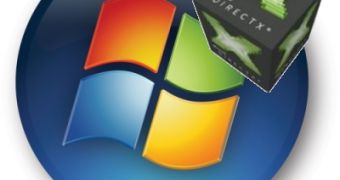Microsoft has issued a paper that summarizes the new features and enhancements brought to desktop and graphics architecture in Windows 7, and also provides guidelines and system design recommendations. The paper has been issued for system designers, display driver developers, and test managers at OEMs and IHVs interested in designing and delivering desktop and mobile PC products for Windows 7.
According to the paper, the GPU must feature support for DirectX10 and higher, as well as for the Windows Display Driver Model (WDDM) v 1.1 - “Optimized for Windows 7.” The graphics solutions that meet these requirements can also “use innovations such as the new Direct2D API”, says the paper, which adds that the new operating system comes with enhancements meant to provide easy usage and leveraged experience.
The Windows 7 operating system is said to introduce new features and key improvements in performance of two-dimensional (2-D), three-dimensional (3-D), and video engines of the modern GPUs. The WDDM driver model comes with “graphics device interface (GDI) hardware acceleration of the GPUs 2-D engine,“ meant to reduce the memory footprint of Aero.
When it comes to 3D, Windows 7 features the Desktop Window Manager (DWM), which makes use of the latest Microsoft Direct3D API and benefits from the 3-D engine of a DirectX10-capable graphics solution. According to the paper, “The new Direct2D API is also based on the high-performance Direct3D 10 API. Gaming innovations led to the development of Direct3D 11, which is a strict superset of Direct3D 10.“
The DirectX Video Acceleration - High Definition (DXVA-HD) is meant to improve the security of graphics data and the use of overlay presentations, while WDDM v1.1 comes with optional features for video playback.
WDDM v1.1, Direct3D 11 and Direct2D API will bring enhancements from the software perspective as well. According to the paper, “Windows 7 introduces the next generation Direct3D 11 API, which is a strict superset of Direct3D 10. Direct3D 11 adds features to the existing DirectX 10 (and 10.1) pipeline that improve 3-D performance and support data-parallel computing on the GPU”.
Direct3D 11 will introduce a range of new features, including a new compute shader, meant to allow the graphics cards to be used as data-parallel processors, software display lists and multithreaded resource handling, tessellation, designed to shrink “the gap between higher quality offline content creation and faster real-time rendering“.
Other features of the new standard include improved texture compression, which ensures that textures and imagery in 3-D applications will look better and improvements to the high-level shading language, offering a more expressive, more flexible programming model for independent software vendors. In the end, the Direct3D 11 is able to provide an efficient, robust, and scalable access to functionality on the future GPUs for games, data-parallel and high-end 3-D applications running under Windows 7.
Detailed information about the features and enhancements brought by Windows 7 can be found under “High Fidelity Graphics in Windows 7: A Guide for OEMs and IHVs” on the WHDC Web site.

 14 DAY TRIAL //
14 DAY TRIAL //